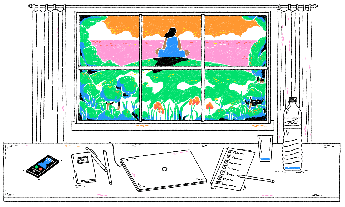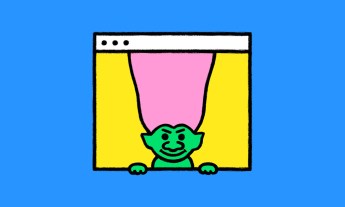
Digital minimalist Cal Newport shows how you can turn off the information firehose and follow current events on your own terms. Are you ready to join the attention resistance?
In 2010, a trio of Germans with backgrounds in sociology, technology and market research posted a document titled “Das Slow Media Manifest” (the English translation is “The Slow Media Manifesto”). Following the Slow Food movement — which promotes local food and cuisine as an alternative to fast food — the Slow Media Manifesto notes that the first decade of the 21st century “brought profound changes to the technological foundations of the media landscape.” The second decade, it proposes, should be dedicated to figuring out the “appropriate reaction.”
Their suggestion: We can embrace the concept of “slow.” In an age in which the digital attention economy is shoveling more and more clickbait toward us and fragmenting our focus into emotionally charged shards, the right response is to become more mindful in our media consumption.
The Slow Media movement is still mostly European; in the US, the response has proved more puritanical. Whereas the Europeans suggest transforming media consumption into a high‑quality experience, Americans have tended to embrace the “low information diet”: a concept popularized by author Tim Ferriss, in which you aggressively eliminate sources of news and information to reclaim time for other pursuits. Much like the American approach to healthy eating, it focuses on eliminating what’s bad rather than on celebrating what’s good.
While the Slow Media Manifesto addresses producers and consumers of media, I want to focus on consumption, with an emphasis on the news — since this is an aspect that makes us particularly vulnerable to attention exploitation. Many of us consume news by cycling through a set sequence of websites and social media feeds. For example, if you’re into technology, Hacker News and Reddit might be at the top of your list. If you’re into sports, you’ll include ESPN.com and team‑specific fan pages, and so on.
Crucial to this news consumption habit is its ritualistic nature. You don’t make a conscious decision about each site and newsfeed you visit; once the sequence is activated, it unfolds on autopilot. We’re so used to this behavior that it’s easy to forget it’s largely a product of the digital attention economy. These media companies love your ritual, because each time you pass through your cycle deposits more pennies in their bank account. Checking 10 sites 10 times a day makes them money — even if it doesn’t leave you more informed than checking one good site once a day.
To embrace news media from a mindset of slowness requires that you focus only on the highest‑quality sources. Breaking news, for example, is almost always lower quality than the reporting after an event has occurred and reporters have processed it. A journalist told me that following a breaking story on Twitter gives him the sense that he’s receiving lots of information, but in his experience, waiting until the next morning to read about the story in the Washington Post almost always leaves him more informed. Unless you’re a breaking news reporter, it’s usually counter-productive to drink from the fire hose of incomplete, redundant and often contradictory information that spews forth in response to noteworthy events.
Consider limiting your attention to the best of the best writers. They don’t have to write for a big, established organization — a powerful voice on a personal blog can be as high quality as a longtime reporter for the Economist — but they should have proven to you to be reliably smart and insightful. When an issue catches your attention, check in on what the people you respect most think about it, rather than wade into a Twitter hashtag search or the comments littering your Facebook timeline. It’s a general rule of slow movements that a small amount of high-quality offerings is usually superior to a larger amount of low-quality fare.
If you’re interested in political and cultural issues, your experience can be enhanced by seeking out the best arguments against your position. I live in Washington, DC, and I know political operatives on both sides of the aisle. A requirement of their job is that they stay on top of the best opposing arguments. A side effect is that they tend to be much more interesting to chat with about politics. In private, they don’t exhibit the anxious urge to tilt at strawman versions of contrary viewpoints, and instead they isolate the key underlying issues or identify the nuances that complicate the matter at hand. As we’ve known since the time of Socrates, engaging with arguments provides a deep source of satisfaction independent of the content of the debate.
Another important aspect of slow news consumption is the decisions you make regarding how and when consumption occurs. I recommend isolating your news consumption to set times during the week and choosing a location that supports you in giving your full attention. I also suggest that you consider the particular format in which you do your reading.
For example, you could look through a paper newspaper each morning over breakfast. This will bring you up to speed on the major stories and provide a more interesting mix of stories than you’d curate for yourself online. On Saturday mornings, perhaps you check a selected group of online news sites and columnists, bookmarking articles you want to dive deeper into, before heading to a coffee shop with your tablet to read this week’s worth of deeper articles and commentary. If you can download the articles, so you can read them without the distractions offered by an internet connection, that’s even better. Serious news consumers often deploy browser plug‑ins or aggregation tools that present them with articles stripped clean of ads and clickbait.
If you follow the above approach to news consumption, you’ll remain informed about current events and up to speed on the ideas in the spaces you care most about. But you’ll accomplish this without sacrificing your time and emotional health to frantic clicking.
The key to embracing Slow Media is the general commitment to maximizing the quality of what you consume and the conditions under which you consume it. If you’re serious about joining the attention resistance, you should be serious about adopting this attitude when interacting with information on the internet.
Adapted from the new book Digital Minimalism: Choosing a Focused Life in a Noisy World by Cal Newport with permission of Portfolio, an imprint of Penguin Publishing Group, a division of Penguin Random House LLC. Copyright © Cal Newport, 2019.
Watch his TEDxTysons talk here:












